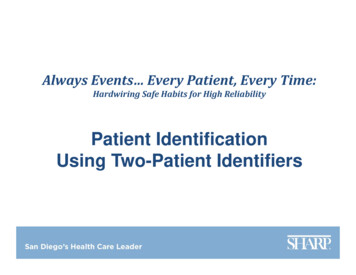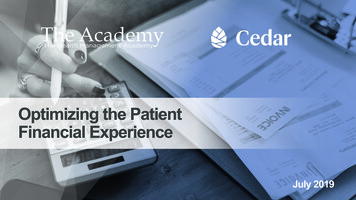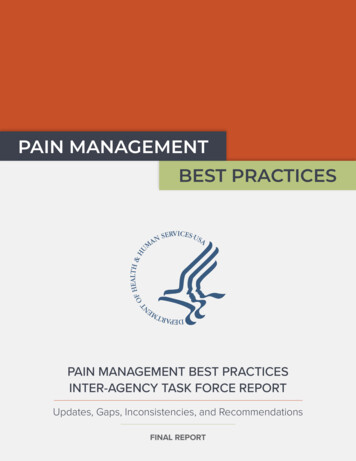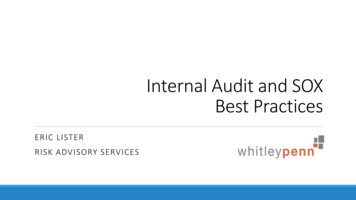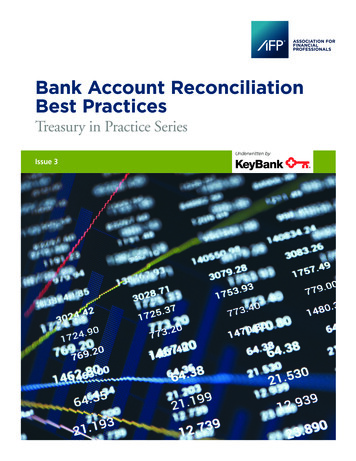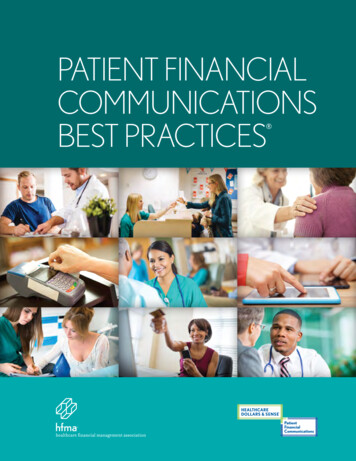
Transcription
PATIENT FINANCIALCOMMUNICATIONSBEST PRACTICES
Patient Financial Communications Best Practices Steering CommitteePamela AtkinsonNancy Davenport-EnnisJames E. Sabin, MDCommunity advocate, nationallyrecognized advocate for the poorFounder and CEO, National PatientAdvocate FoundationAttorney General (Ret.)Thurbert Baker (Co-chair)Joseph J. Fifer, FHFMA, CPAClinical Professor, Departments ofPopulation Medicine and Psychiatry,Harvard Medical SchoolPartner, McKenna Long & AldridgeLaw FirmGerald E. Bisbee, Jr., PhDChairman and CEO, The HealthManagement AcademyRichard L. Clarke, DHA,FHFMA (Co-chair)President and CEO, HealthcareFinancial Management AssociationKaren IgnagniFormer President and CEO,America’s Health Insurance PlansMike JacoutotMary A. TolanFounder and Chairman, AccretiveHealthRobert L. Wergin, MDBoard of Directors, American Academyof Family PhysiciansFormer CEO, Optimum OutcomesBert ZimmerliRetired President and CEO, HealthcareFinancial Management AssociationPatricia KeelExecutive Vice President andChief Financial Officer,Intermountain HealthcareAaron CraneMaureen MudronChief Financial and Strategy Officer,Salem HealthDeputy General Counsel, AmericanHospital AssociationCFO, Good Shepherd Medical CenterThe following national policymakers advised the project: Sen. Tom Daschle (D.-S.D.),Sen. Bill Frist (R.-Tenn.), former U.S. Secretary of Health and Human Services Donna Shalala,Gov. Michael Leavitt (R-Utah), and former U.S. Deputy Attorney General Jamie Gorelick.
Dear Healthcare Leader:Thank you for your interest in HFMA’s PATIENT FINANCIALCOMMUNICATIONS BEST PRACTICES . At HFMA, we believe thatensuring a good financial experience for patients is important formany reasons—it reduces administrative costs and improvesfinancial results for healthcare organizations, it enhances patientsatisfaction and loyalty, and—perhaps most importantly—it helpspatients make better decisions about their health care.That’s why we worked with leading organizations from all sectors of the industry to developthese best practices. HFMA then went on to create an online training program and arecognition program based on the Best Practices. Some of the leading healthcare providerorganizations in the country have sought and achieved Adopter recognition. To view a currentlist, visit hfma.org/adopterorganizations.In the process of applying for Adopter recognition, you will perform a self-assessment thatcan yield valuable information about where your organization’s financial communicationsprocesses could benefit from improvement. Or you may receive validation that your financialcommunications processes are already aligned with industry consensus best practices.By receiving Adopter recognition, you will demonstrate your commitment to excellence infinancial communications to your patients as well as to your employees, physicians, andcommunity. In doing so, you not only strengthen your organization’s reputation, you alsohelp maintain consumer trust in health care overall. We look forward to welcoming you tothe Best Practices Adopter community.Very best,Joseph J. Fifer, FHFMA, CPAPresident and CEOHealthcare Financial Management AssociationHFMA .ORG/COMMUNICATIONSPATIENT FINANCIAL COMMUNICATIONS BEST PRACTICES1
PATIENT FINANCIALCOMMUNICATIONS BEST PRACTICES These common-sense best practices bring consistency, clarity, and transparency to patient financialcommunications, and outline steps to help patients understand the cost of services they receive, theirinsurance coverage, and their individual responsibility. The best practices are organized into five sections:1) Emergency Department, (2) Time of Service (Outside the Emergency Department), (3) Advance ofService, (4) All Settings, and (5) Measurement Criteria. The best practices are listed on the following pages.SECTION 1.Best Practices for the Emergency DepartmentAll practices must comply with the Emergency Medical Treatment and Labor Act (EMTALA) and all other federal, state,and local regulations affecting the Emergency Department1.1. Discussion participants. The patient or guarantor will have these discussions with a properly trained registrationor discharge representative for routine scenarios; financial counselor or supervisor for non-routine/complex scenarios.Patients should be given the opportunity to request a patient advocate, designee or family member to assist them in thesediscussions.1.2. Setting for discussions. No patient financial discussions will occur before the patient is screened and stabilized.Once a patient has been stabilized, in accordance with EMTALA, the following timings and locations are appropriate forfinancial discussions.1.2.1. Emergent patients. Discussions will occur during the discharge process. The discussion can also occur duringthe medical encounter as long as patient care is not interfered with and the patient consents to these conversations inorder to expedite discharge.1.2.2. Patients who do not have an emergency medical condition. Following the medical screening, the providerrepresentative will have a discussion with the patient during the registration or discharge process. The discussioncan also occur during the medical encounter as long as patient care is not interfered with and the patient consents tothese discussions in order to expedite discharge.HFMA .ORG/COMMUNICATIONSPATIENT FINANCIAL COMMUNICATIONS BEST PRACTICES2
PATIENT FINANCIAL COMMUNICATIONS BEST PRACTICES Section 1. Best Practices for the Emergency Department(CO NTI N U ED)1.3. Registration, insurance verification, and financial counseling discussions. No patient financial discussions willoccur before the patient is screened and stabilized, in accordance with EMTALA.1.3.1. Registration. The provider organization will first gather basic registration information, includingdemographics and insurance coverage, as well as determining the potential need for financial assistance.1.3.2. Provision of care. Patients will be informed that their ability to pay will not interfere with treatment of anyemergency medical conditions. Uninsured patients will be informed that the goal of collecting information is toidentify payment solutions or financial assistance options that may assist them with their obligations for this visit.1.3.3. Insurance verification. Once screening has occurred and the patient is stabilized, the provider organizationwill review insurance eligibility information with the patient to ensure information accuracy.1.3.4. Financial counseling. If appropriate, the patient is referred to a financial counselor and/or offered informationregarding the provider’s financial counseling services and assistance policies.1.4. Patient share and prior balance discussions. These discussions will occur once the provider organization hasfulfilled the previous best practice requirements. Interactions will not interfere with patient care, and will focus onpatient education. During patient share and prior balance discussions, the provider representative will take thefollowing actions.1.4.1. Patient share discussions1.4.1.1. Provide a list of the types of service providers that typically participate in the service, both verbally, and ifthe patient requests, in writing.1.4.1.2. Inform the patient that actual out-of-pocket costs may vary from estimates, depending on the actualservices performed or timing issues with other payments affecting the patient’s deductible.1.4.1.3. If appropriate, ask if the patient is interested in receiving information regarding payment options.1.4.1.4. If appropriate, ask if the patient is interested in receiving information regarding the provider’s financialassistance programs.1.4.2. Prior balance discussions. A balance resolution discussion occurs on prior balances that are being pursued forcollection by a provider, collection agency, or other organization. There will be many scenarios where patients willnot have prior balances.1.4.2.1. Discuss with the patient the services that led to the prior balance, including the dates of service and theresulting prior balance. Upon the patient’s request, provide the patient a written list of the services provided,dates of service, and the resulting prior balance.1.4.2.2. Ask if the patient is interested in receiving information regarding payment options.1.4.2.3. Ask if the patient is interested in receiving information regarding the provider’s supportive financialassistance programs.1.4.2.4. Proactively attempt to resolve prior balances through insurance and financial assistance programs.HFMA .ORG/COMMUNICATIONSPATIENT FINANCIAL COMMUNICATIONS BEST PRACTICES3
PATIENT FINANCIAL COMMUNICATIONS BEST PRACTICES Section 2. Best Practices at the Time of Service (Outside the Emergency Department)(CO NTI N U ED)1.5. Balance resolution. Once the provider organization has fulfilled the best practice steps as outlined above, it isappropriate to inquire about how the patient would like to resolve the balance for the current service and any priorbalance the patient may have, as well as informing the patient of the timing of collection activity.1.6. Summary of care documentation. During the discharge process, the patient will receive, in writing, informationregarding the provider’s supportive financial assistance programs, and a summary of the potential financialimplications for the services rendered, including a phone number to call with questions.SECTION 2 .Best Practices at the Time of Service (Outside the Emergency Department)2.1. Discussion participants. The patient or guarantor will have these discussions with properly trained registration ordischarge representative for routine scenarios; financial counselor or supervisor for non-routine / complex scenarios.Patients should be given the opportunity to request a patient advocate, designee, or family member to assist them inthese discussions.2.2. Setting for discussions. The provider organization will have these discussions with patients during theregistration or discharge process in a location that does not disrupt patient flow. The discussion can also occur during themedical encounter as long as patient care is not interfered with and the patient consents to these discussions in order toexpedite discharge.2.3. Registration, insurance verification, and financial counseling discussions. Provider organizations will maintaina thread of pre-registration discussions that occurred with the patient. If pre-registration discussions took place, thesediscussions will not occur again.2.3.1. Registration. The provider organization will first gather basic registration information, includingdemographics and insurance coverage, as well as determining the potential need for financial assistance.2.3.2. Insurance verification. The provider organization will review insurance eligibility details with the patient toensure information accuracy. Uninsured patients will be informed that the goal of collecting information is toidentify payment solutions or financial assistance options that may assist them with their obligations for this visit.HFMA .ORG/COMMUNICATIONSPATIENT FINANCIAL COMMUNICATIONS BEST PRACTICES4
PATIENT FINANCIAL COMMUNICATIONS BEST PRACTICES Section 2. Best Practices at the Time of Service (Outside the Emergency Department)(CO NTI N U ED)2.3.3. Financial counseling. If appropriate, the patient is referred to a financial counselor and/or offeredinformation regarding the provider’s financial counseling services and assistance policies.2.4. Provision of care. Provider organizations will have clear policies on how to interact with patients with priorbalances choosing to have elective or non-elective procedures. They will also have clear definitions for elective andnon-elective procedures. These policies will be made available to the public.2.4.1. Elective services (as defined by the provider)2.4.1.1. Patient share discussions. Patients have the obligation to make satisfactory payment arrangements beforereceiving care.2.4.1.2. Prior balance discussions. Patients with prior balances will be informed by the provider organization ifthe provider’s policies regarding prior balances mean the service will be deferred.2.4.2. Non-elective services (as defined by the provider)2.4.2.1. Patients will be informed that ability to resolve patient share or any prior balances will not affectprovision of care.2.5. Patient share and prior balance discussions. Discussions will not interfere with patient care and will focus onpatient education. During patient share and prior balance discussions, the provider representative will take thefollowing actions.2.5.1. Patient share discussions2.5.1.1. Provide a list of the types of service providers that typically participate in the service, both verbally, andif the patient requests, in writing.2.5.1.2. Inform the patient that actual out-of-pocket costs may vary from estimates depending on the actualservices performed or timing issues with other payments affecting the patient’s deductible.2.5.1.3. If appropriate, ask if the patient is interested in receiving information regarding payment options.2.5.1.4. If appropriate, ask if the patient is interested in receiving information regarding the provider’s financialassistance programs.2.5.2. Prior balance discussions. Balance resolution discussions occur on prior balances that are being pursued forcollection by a provider, collection agency, or other organization. There will be many scenarios where patients willnot have prior balances.2.5.2.1. Discuss with the patient the services that led to the prior balance, including the dates of service and theresulting prior balance. Upon the patient’s request, provide the patient a written list of the services provided,dates of service, and the resulting prior balance.2.5.2.2. If appropriate, ask if the patient is interested in receiving information regarding payment options.2.5.2.3. If appropriate, ask if the patient is interested in receiving information regarding the provider’ssupportive financial assistance programs.2.5.2.4. Proactively attempt to resolve prior balances through insurance and financial assistance programs.HFMA .ORG/COMMUNICATIONSPATIENT FINANCIAL COMMUNICATIONS BEST PRACTICES5
PATIENT FINANCIAL COMMUNICATIONS BEST PRACTICES Section 3. Best Practices in Advance of Service(CO NTI N U ED)2.6. Balance resolution. Once the provider organization has fulfilled the best practice steps as outlined above, it isappropriate to inquire about how the patient would like to resolve the balance for the current service and any priorbalance the patient may have, as well as informing the patient of the timing of collection activity.2.7. Summary of care documentation. During the registration or discharge process, the patient will receive in writing,information regarding the provider’s supportive financial assistance programs, and a summary of the potential financialimplications for the services rendered, including a phone number to call with questions.SECTION 3.Best Practices in Advance of Service3.1. Discussion participants. Appropriately trained provider representatives will have these discussions with thepatient or guarantor. Patients should be given the opportunity to request a patient advocate, designee, or family memberto assist them in these discussions.3.2. Setting for discussions. Discussions will occur using the most appropriate means of communication for thepatient. These discussions may take place via: Outbound contact to patient in advance of a scheduled service Inbound contact from patient inquiring about their upcoming service Scheduling/Contact center when appointment is made3.3. Timing of discussions. A reasonable attempt will be made for discussions with patients to occur as early aspossible, taking place before a financial obligation is incurred up to the point at which care is provided. Timelydiscussions will ensure patients understand their financial obligation and providers are aware of the patient’s ability topay and/or source of payment.3.4. Registration, insurance verification, and financial counseling discussions. Provider organizations will maintaina thread of pre-registration discussions that occurred with the patient. If pre-registration discussions took place, thesediscussions will not occur again.HFMA .ORG/COMMUNICATIONSPATIENT FINANCIAL COMMUNICATIONS BEST PRACTICES6
PATIENT FINANCIAL COMMUNICATIONS BEST PRACTICES Section 3. Best Practices in Advance of Service(CO NTI N U ED)3.4.1. Registration. The provider organization will first gather basic registration information, includingdemographics and insurance coverage, as well as determining the potential need for financial assistance.3.4.2. Insurance verification. The provider organization will review insurance eligibility with the patient to ensureinformation accuracy. Uninsured patients will be informed that the goal of collecting information is to identifypayment solutions or financial assistance options that may assist them with their obligations for this visit.3.4.3. Financial counseling. If appropriate, the patient is referred to a financial counselor and/or offeredinformation regarding the provider’s financial counseling services and assistance policies.3.5. Provision of care. Provider organizations will have clear policies on how to interact with patients with priorbalances choosing to have elective or non-elective procedures. They will also have clear definitions for elective andnon-elective procedures. These policies will be made available to the public.3.5.1. Elective services (as defined by the provider)3.5.1.1. Patient share discussions. Patients have the obligation to make satisfactory payment arrangements beforereceiving care.3.5.1.2. Prior balance discussions. Patients with prior balances will be informed by the provider organization ifthe provider’s policies regarding prior balances mean the service will be deferred.3.5.2. Non-elective services (as defined by the provider)3.5.2.1. Patients will be informed that ability to resolve patient share or any prior balances will not affectprovision of care.3.6. Patient share and prior balance discussions. Interactions will not interfere with patient care, and will focus onpatient education. During patient share and prior balance discussions, the provider representative will take thefollowing actions.3.6.1. Patient share discussions.3.6.1.1. Provide a list of the types of service providers that typically participate in the service, both verbally, andif the patient requests, in writing.3.6.1.2. Inform the patient that actual out-of-pocket costs may vary from estimates, depending on the actualservices performed or timing issues with other payments affecting the patient’s deductible.3.6.1.3. If appropriate, ask if the patient is interested in receiving information regarding payment options.3.6.1.4. If appropriate, ask if the patient is interested in receiving information regarding the provider’s financialassistance programs.3.6.2. Prior balance interactions discussions. A balance resolution discussion occurs on prior balances that arebeing pursued for collection by a provider, collection agency, or other organization. There will be many scenarioswhere patients will not have prior balances.HFMA .ORG/COMMUNICATIONSPATIENT FINANCIAL COMMUNICATIONS BEST PRACTICES7
PATIENT FINANCIAL COMMUNICATIONS BEST PRACTICES Section 4. Best Practices for All Settings(CO NTI N U ED)3.6.2.1. Discuss with the patient the services that led to the prior balance, including the dates of service and theresulting prior balance. Upon the patient’s request, provide the patient a written list of the services provided,dates of service, and the resulting prior balance.3.6.2.2. If appropriate, ask if the patient is interested in receiving information regarding payment options.3.6.2.3. If appropriate, ask if the patient is interested in receiving information regarding the provider’ssupportive financial assistance programs.3.6.2.4. Proactively attempt t
Management Academy Richard L. Clarke, DHA, FHFMA (Co-chair) Retired President and CEO, Healthcare Financial Management Association Aaron Crane Chief Financial and Strategy Officer, Salem Health Nancy Davenport-Ennis Founder and CEO, National Patient Advocate Foundation Joseph J. Fifer, FHFMA, CPA President and CEO, Healthcare




